Shipping Container Dimensions: Size Charts, Specifications & Capacity Guide
Distinguishing between standard and high-cube storage container sizes: standard containers stand 8 feet 6 inches tall, while high-cube containers measure 9 feet 6 inches in height. Pelican Containers stocks both sizes, with the high cube (HC) variation being the preferred choice among customers for 40-foot containers. Standard (STD) container sizes are typically chosen only when height restrictions are a concern at the delivery site.
Explore shipping container sizes and prices at Pelican Containers today for a highly profitable solution! We always provide information about what size shipping containers are and assist you in finding the right shipping container size for your needs.
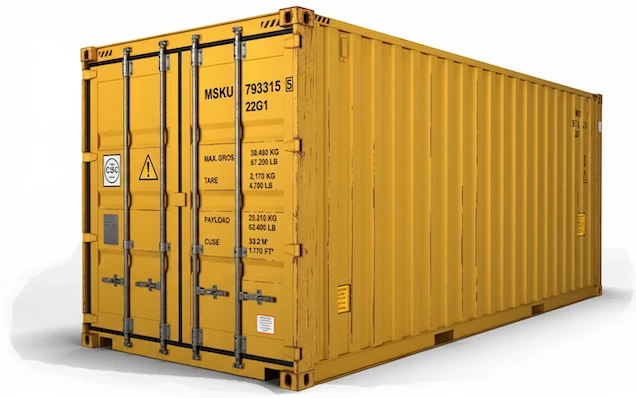
20Ft Shipping Containers Sizes
40Ft Shipping Containers Sizes
45Ft Shipping Containers Sizes
53Ft Shipping Containers Sizes
Pelican Containers is one of the most popular providers of 20ft shipping containers for sale in the shipping industry in the USA. You can buy a 20ft shipping container in any condition you need. You can get your 20ft container worldwide and use it for any purpose you need.
Pelican Containers is one of the most popular providers of 40ft shipping containers for sale in the shipping industry in the USA. You can buy a 40ft shipping container in any condition you need. You can get your 40ft container worldwide and use it for any purpose you need.
Pelican Containers is one of the most popular providers of 45ft shipping containers for sale in the shipping industry in the USA. You can buy a 45ft shipping container in any condition you need. You can get your 45ft container worldwide and use it for any purpose you need.
Pelican Containers is one of the most popular providers of 53ft shipping containers for sale in the shipping industry in the USA. You can buy a 53ft shipping container in any condition you need. You can get your 53ft container worldwide and use it for any purpose you need.
20Ft Shipping Containers Sizes
Pelican Containers is one of the most popular providers of 20ft shipping containers for sale in the shipping industry in the USA. You can buy a 20ft shipping container in any condition you need. You can get your 20ft container worldwide and use it for any purpose you need.
40Ft Shipping Containers Sizes
Pelican Containers is one of the most popular providers of 40ft shipping containers for sale in the shipping industry in the USA. You can buy a 40ft shipping container in any condition you need. You can get your 40ft container worldwide and use it for any purpose you need.
45Ft Shipping Containers Sizes
Pelican Containers is one of the most popular providers of 45ft shipping containers for sale in the shipping industry in the USA. You can buy a 45ft shipping container in any condition you need. You can get your 45ft container worldwide and use it for any purpose you need.
53Ft Shipping Containers Sizes
Pelican Containers is one of the most popular providers of 53ft shipping containers for sale in the shipping industry in the USA. You can buy a 53ft shipping container in any condition you need. You can get your 53ft container worldwide and use it for any purpose you need.
How many square feet are in shipping containers?
How many cubic feet do shipping containers have?
High cube containers vs. standard shipping containers
The floor area of a container is one of the most important aspects when evaluating storage container sizes. Here’s a breakdown by standard container types:
- 20 ft shipping containers: ~148 sq ft (13.75 m²);
- 40 ft containers: ~304 sq ft (28.2 m²);
- 45 ft containers: ~343 sq ft (31.9 m²);
- 53 ft containers: ~431 sq ft (40 m²).
These shipping container measurements are commonly used to calculate available space for freight, conversion projects, or warehousing. Keep in mind that internal dimensions slightly differ from external specs due to wall thickness.
Volume plays a big role in container capacity. Here’s how the dimensions of shipping containers translate to internal volume:
- 20ft: ~1,170 cubic ft.
- 40ft: ~2,385 cubic ft.
- 45ft: ~3,040 cubic ft.
- 53ft container dimensions (internal): ~3,855 cubic ft.
Understanding storage container dimensions in cubic feet is essential for loading decisions, especially when dealing with open top shipping containers or bulk cargo.
The key difference between high cube and standard models is height. While most standard containers are 8′ 6″ tall, high cube containers typically offer an extra foot. That added space can be a game changer in specific industries.
For instance:
- Standard 40ft: Shipping container height is 8′ 6″.
- High Cube 40ft: Height is 9′ 6″.
That extra foot increases volume significantly. Here’s how the high cube shipping container dimensions compare:
- 20ft High Cube: ~1,520 cubic ft vs 1,172 cubic ft for 20ft standard.
- 40ft High Cube: ~2,694 cubic ft vs 2,385 cubic ft for 40ft standard.
- 45ft High cube: ~3,122 cubic ft.
- 53ft High Cube: ~3,855 cubic ft.
When considering shipping container sizes, the height boost makes high cubes better for light, voluminous cargo or conversions into habitable spaces.
No matter the size of the shipping container you’re dealing with, be it a compact 20ft shipping container or a larger 53 ft container, each variation serves a specific need. From accurate shipping container width to total volume, proper knowledge of shipping container dimensions prevents wasted space and poor planning. If you’re still asking how tall shipping containers are, the answer depends on whether you’re looking at a standard or a high cube — just remember that foot of difference.
How many square feet are in shipping containers?
The floor area of a container is one of the most important aspects when evaluating storage container sizes. Here’s a breakdown by standard container types:
- 20 ft shipping containers: ~148 sq ft (13.75 m²);
- 40 ft containers: ~304 sq ft (28.2 m²);
- 45 ft containers: ~343 sq ft (31.9 m²);
- 53 ft containers: ~431 sq ft (40 m²).
These shipping container measurements are commonly used to calculate available space for freight, conversion projects, or warehousing. Keep in mind that internal dimensions slightly differ from external specs due to wall thickness.
How many cubic feet do shipping containers have?
Volume plays a big role in container capacity. Here’s how the dimensions of shipping containers translate to internal volume:
- 20ft: ~1,170 cubic ft.
- 40ft: ~2,385 cubic ft.
- 45ft: ~3,040 cubic ft.
- 53ft container dimensions (internal): ~3,855 cubic ft.
Understanding storage container dimensions in cubic feet is essential for loading decisions, especially when dealing with open top shipping containers or bulk cargo.
High cube containers vs. standard shipping containers
The key difference between high cube and standard models is height. While most standard containers are 8′ 6″ tall, high cube containers typically offer an extra foot. That added space can be a game changer in specific industries.
For instance:
- Standard 40ft: Shipping container height is 8′ 6″.
- High Cube 40ft: Height is 9′ 6″.
That extra foot increases volume significantly. Here’s how the high cube shipping container dimensions compare:
- 20ft High Cube: ~1,520 cubic ft vs 1,172 cubic ft for 20ft standard.
- 40ft High Cube: ~2,694 cubic ft vs 2,385 cubic ft for 40ft standard.
- 45ft High cube: ~3,122 cubic ft.
- 53ft High Cube: ~3,855 cubic ft.
When considering shipping container sizes, the height boost makes high cubes better for light, voluminous cargo or conversions into habitable spaces.
No matter the size of the shipping container you’re dealing with, be it a compact 20ft shipping container or a larger 53 ft container, each variation serves a specific need. From accurate shipping container width to total volume, proper knowledge of shipping container dimensions prevents wasted space and poor planning. If you’re still asking how tall shipping containers are, the answer depends on whether you’re looking at a standard or a high cube — just remember that foot of difference.
About Shipping Containers
The information listed on intermodal shipping container doors is standardized so that the container can be handled at any port in the world. From the manufacturer information on the CSC plate, to the size & capacity information, to the container identification number, everything is standardized on a shipping container.
Furthermore, to ensure the same equipment can safely handle the containers anywhere in the world, shipping containers are held to a very specific set of specifications and dimensions.
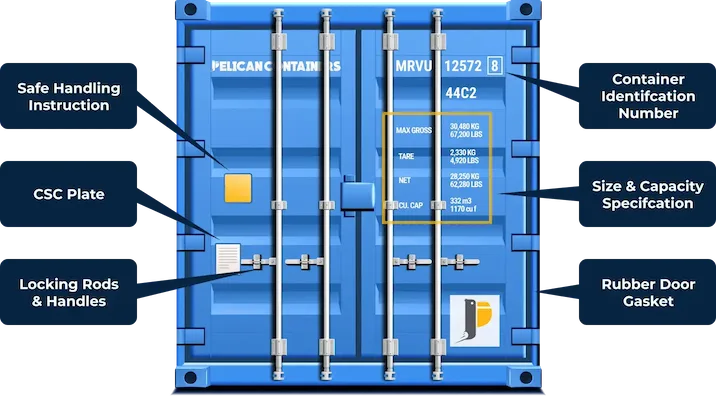
Safe Handling Instructions
A sticker or plate identifying such things as High Cube containers, hazardous cargo, or other such labels. High-Cube shipping containers will also have yellow decals at the top of the frame on each end to make the extended height more noticeable. High Cube containers have an outside height of 9’6″ (one foot taller than standard shipping containers, which are 8’6″ tall).
CSC Plate
The Convention for Safe Containers (CSC) Plate provides crucial details such as the date and location of manufacture, along with other specifications. For more information on the Convention for Safe Containers, visit the International Maritime Organization’s website. If you plan to use your shipping container for export, be sure to obtain a CSC survey.
Locking Rods & Handles
Locking rods are bolted to the exterior of the shipping container’s cargo doors and frame, sealing the door tightly when twisted closed and clasped. A broken or bent locking rod can prevent a door from sealing properly. We guarantee that the doors will seal on every shipping container we sell. However, it’s always a good idea to grease the hinges and ensure the door frame is square.
Container Identifcation Number
Every shipping container has a unique identification number. The first three letters represent the container owner (registered with the Bureau International des Containers, or “BIC”). These are followed by: a “U” (indicating a dry container), six numerical digits for the unit number, and A 7th check digit, calculated based on the values of the preceding letters and numbers. To ensure accuracy, always verify your check digit with BIC.
Size & Capacity Specifcation
To ensure safe handling and stacking on ships, containers should not be loaded heavier than the weight specifications listed on the door and CSC plate. Please note: local shipping weight regulations may be much lower than the maximum payload of the container. For instance, many shipping containers can handle over 65,000 lbs of cargo, but a load that large exceeds FMCSA regulations.
Rubber Door Gasket
Every cargo door comes with a thick rubber gasket that runs around the entire frame. You might not think much about these seals, but here’s why they’re crucial: Blocks rain, wind, and dust – No one wants soggy cargo or a dusty interior. Locks in your freight – Even if pallets shift during rough transport, the seal helps keep everything contained. Let’s be honest: if the gasket fails, your container isn’t waterproof anymore. That’s why we warranty ours for a full year—no questions asked.
The information included on the CSC Plate
A certain amount of information, in either English or French, must be included on every CSC plate. For example, the words “CSC SAFETY APPROVAL” are prominently displayed on the plate, together with the approval reference and the country of approval.
The month and year the container was made, as well as the manufacturer’s container identification number, or the operating number of the Container Operator (using a “BIC Code”), must be visible.
The maximum weight-carrying capabilities of the container (commonly referred to as “Payload” or “max net mass”) in kg and pounds, as well as the stacking and racking test load value, must also be inscribed on the plate.
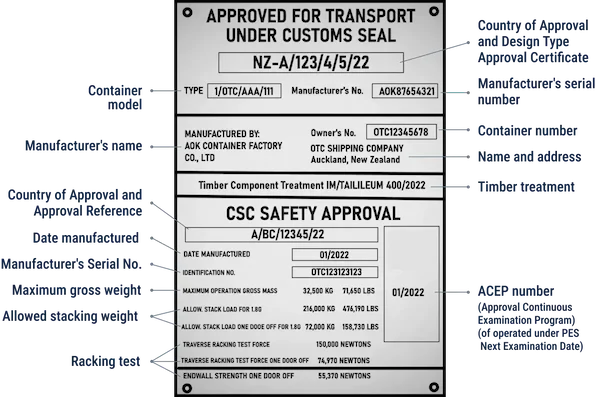
Used Shipping Containers For Sale
Availability with Pelican Containers
In North America, the prevailing sizes for shipping containers are 20 feet and 40 feet in length, with a fixed width of 8 feet across all units transported by cargo ships, except for 53-foot containers, which adhere to rail standards and measure 8 feet 6 inches wide.
Major coastal depots like Los Angeles, Houston, Miami, New York, and Chicago boast an ample inventory of shipping containers in various grades, sizes, and configurations. Conversely, inland depots such as Denver, Kansas City, Las Vegas, and Salt Lake City tend to have more limited availability, typically stocking only the most common shipping container sizes and grades.
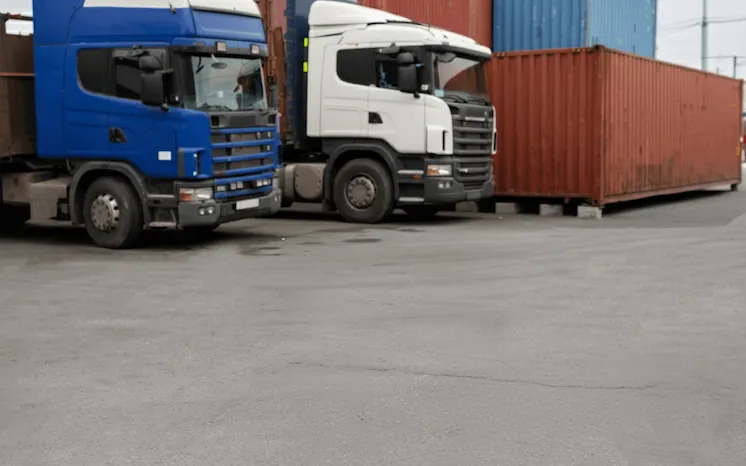
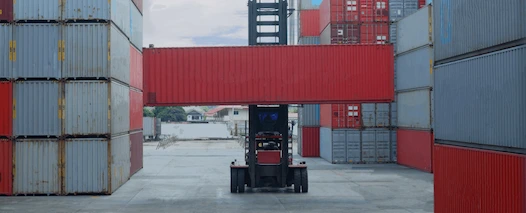
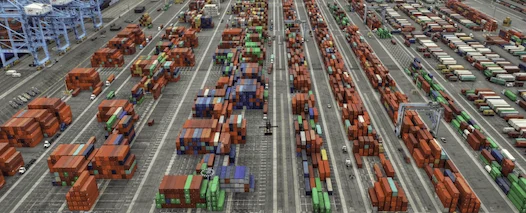
FAQ:
What size of shipping containers is a standard?
The standard sizes for shipping containers are 20 feet and 40 feet in length, with a width of 8 feet. High cube containers, offering an additional foot in height, are also popular.
How do I choose the right size of shipping container for my needs?
Selecting the right size depends on your specific requirements, such as the volume of goods, the nature of the items being stored or transported, and any site height restrictions. Our team can assist you in determining the most suitable container size.
Are customized shipping container sizes available?
Yes, customized shipping container sizes are available to meet specific needs. Contact us with your requirements, and we can provide tailored solutions.
How can I check how big are shipping containers before placing an order?
You can check the availability of a specific container size by contacting our customer service team or checking our website. We provide up-to-date information on inventory levels at various depots.
What are the dimensions of a High-Cube shipping container?
A high-cube container has the same dimensions as a standard shipping container, with an addition of 1 extra foot to the height. Almost all standard sizes (20 ft, 40 ft, and 45 ft) are available in a high-cube version.
What is the size of a 20ft shipping container?
A 20-foot container is typically 20 feet long, 8 feet wide, and 8 feet 6 inches high (20’0″ x 8’0″ x 8’6″). It’s one of the most common sizes in cargo transport due to its compactness and affordability.
What is the size of a 40ft shipping container?
The 40-foot container comes in at 40 feet in length, 8 feet in width, and 8 feet 6 inches in height (40’0″ x 8’0″ x 8’6″). It’s often a preferable choice for larger shipments that still require standard handling.
What is the size of a 45ft shipping container?
Measuring 45 feet long, 8 feet wide, and 9 feet 6 inches tall (45’0″ x 8’0″ x 9’6″). While a standard 8’6’’-high option exists, this type of container is more commonly found as a high-cube version.
What is the size of a 53ft shipping container?
The 53ft option is 53 feet in length, 8 feet 6 inches in width, and 9 feet 6 inches tall (53’0″ x 8’6″ x 9’6″). Due to the ISO restrictions, 53ft containers are mostly used for on-land transportation.
in touch with you as soon as possible.



